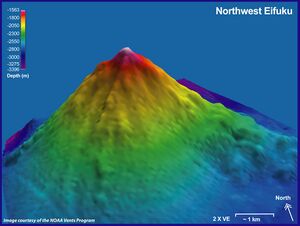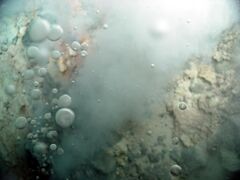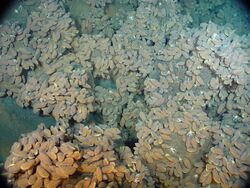Earth:Eifuku
| Eifuku | |
|---|---|
Lua error in Module:Location_map at line 408: Malformed coordinates value.
| |
 Bathymetic image of NW Eifuku as viewed to the northeast | |
| Location | |
| Coordinates | Template:Coord/display/inline,intitle |
Eifuku (Japanese: 永福) and NW Eifuku (北西永福) are two seamounts in the Pacific Ocean. The better known one is NW Eifuku, where an unusual hydrothermal vent called "Champagne" produced droplets of liquid CO2. Both seamounts are located in the Northern Marianas and are volcanoes, part of the Izu-Bonin-Mariana Arc. NW Eifuku rises to 1,535 metres (5,036 ft) depth below sea level and is a 9 kilometres (5.6 mi) wide volcanic cone.
Both Eifuku seamounts are hydrothermally active, with numerous vent sites found on NW Eifuku including the "Champagne" vent site, where there are a number of white smokers. Diverse ecosystems dominated by mussels live in proximity and around the hydrothermal vent sites.
Geography and geology
The Eifuku seamounts are located northwest of Farallon de Pajaros island in the Northern Marianas. Geologically, both Eifuku seamounts are part of the Northern Marianas volcanic arc[1] and are grouped within the Northern Seamount Province.[2] The Northern Marianas are part of the c. 2,500-kilometre (1,600 mi) Izu-Bonin-Mariana Arc between Japan and Guam,[3] which owes its existence to the subduction of the Pacific Plate underneath the Philippine Plate[4] that began in the Eocene. About 40 submarine and island volcanoes make up the Northern Marianas arc.[5]
NW Eifuku and Eifuku are small volcanoes at the northwestern end of a volcano chain that also includes Daikoku,[6] which is larger than NW Eifuku.[7] Daikoku also features hydrothermal venting[8] and has been considered a twin cone with Eifuku.[9] Eifuku proper is composed of boulders, dykes and lava domes.[10] The occurrence of volcanic breccia, hydrothermal muds, sandstone and sulfides has been reported but without a clear attribution to either Eifuku or NW Eifuku.[11]
NW Eifuku seamount rises to 1,535 metres (5,036 ft) depth below sea level[6] and has a roughly conical outline, with a basal width of 9 kilometres (5.6 mi).[12] Its summit is formed by a lava dome that is surrounded by jagged rocks. A ridge, which likely corresponds to a dyke in the crater, runs from the summit and features old and mostly inactive hydrothermal vents. Rocks with columnar joints, lava spines and pillow basalts are found in the summit region.[13] The southwestern slope of NW Eifuku and its summit are cut by the scar of a sector collapse.[6] A northwest-southeast trending fracture may underlie the seamount and could be responsible for the mass wasting observed on the seamount.[14] The venting at "Champagne" appears to indicate that there is degassing magma.[2]
Composition
Rocks erupted by Eifuku range from basalt to andesite[6] that define either a potassium-rich calc-alkaline[15] or a tholeiitic suite.[16] The basalts contain clinopyroxene, olivine and plagioclase and feature abundant vesicles despite the great depth of the volcano.[2] This composition may occur on either NW Eifuku or Eifuku or both seamounts.[11] Sulfur mineralizations exist in the form of crusts, large deposits and also as infill within other rocks.[17] Silica and iron oxides form fluffy sediments.[12]
Hydrothermal vents
Both Eifuku[10] and NW Eifuku are hydrothermally active, with NW Eifuku displaying white smokers[6] and hydrothermal vents dispersed over several sites on the volcano.[18] There are several sites, including diffuse venting at the summit,[19] a low-temperature area at 1,570 metres (5,150 ft) depth and high-temperature vents at 1,610 metres (5,280 ft) depth which include the so-called "Champagne" site[20] about 80 metres (260 ft) west-northwest of the summit.[7] Two other vent sites northeast and north of "Champagne" are known as "Cliff House" and "Sulfur Dendrite", respectively.[21] Additional vents are "Yellow Cone" and "Yellow Top" which are low-temperature iron-rich vents[22] and the latter of which is located south of the summit.[23] A sixth vent site is known as "Bacto Balls".[24] The seawater above NW Eifuku has anomalous composition, a sign of hydrothermal degassing.[7]
Champagne vent
The "Champagne" vent was discovered either in 2004 by the ROPOS remotely operated vehicle (ROV) or[18] by a NOAA expedition in 2003.[lower-alpha 1][6] It lies west of the summit[18] in the sector collapse scar[6] and features both focused (white smokers that form chimneys) and diffuse venting. Temperatures of the discharge reach 105 °C (221 °F)[1] in gas-rich fluids that contain H2S.[18] The chimneys are formed by sulfur.[25]
"Champagne" is known for being one of only two sites on Earth[lower-alpha 2] where liquid CO2 is emitted. The CO2 rises from the pumice and sulfur deposits on the ground[20] through crevices,[21] and it forms cold droplets with a milky skin[18] that stick to surfaces such as ROV tools and ascend slowly[7] owing to their buoyancy under the conditions at the vent. They appear to originate from a layer underneath the ground surface, as disturbing it leads to increasing exhalations.[21] The name "Champagne" is based on the appearance of the exhalations.[28]
Apart from CO2, they contain sulfur compounds and small amounts of hydrogen and methane. CO2 makes up about 87% of the droplets, which are rimmed by CO2 clathrates,[18] the concentrations per unit mass are about twice the solubility of CO2 under the environmental conditions[1] and considerably larger than at other known CO2 venting sites.[29] Eifuku's CO2 output appears to be a significant component of global volcanic CO2 flux, or at least of submarine volcanic CO2 flux.[14] Based on isotope ratios, much of this CO2 is derived from the subduction of carbonates rather than from the mantle.[18] The emission rate may not be steady over time, as output varied between different expeditions.[14]
Biology
Several ecological communities have been found at NW Eifuku, at 1,550 metres (5,090 ft) depth[1] and with distinct microbiotas:[30]
- The "Champagne" site features chemobiosynthetic organisms. Microbial mats lie between the vents. Animals are not frequent here. The shrimp Opaepele loihi is the most important animal species and is accompanied by galatheid crabs, scale worms[1] and vent gastropods.[lower-alpha 3][32] The animals feed mainly at the edges of the mats, where environmental conditions are not as extreme.[28]
- A site called "Mussel bed" is covered with mussels of the Bathymodiolus genus,[1] which cover an area of about 10,000 square metres (110,000 sq ft) with densities of more than 100 mussels per 1 square metre (11 sq ft).[20] Other animals there include harpacticoid copepods,[1] bythograeid[33] and galatheid[lower-alpha 4] crabs, nematodes, polynoid and other polychaetes and alvinocarid[lower-alpha 5] shrimps. This site is awash with hydrothermal discharges from the "Champagne" site, which lies at slightly greater depth.[1] The mussels appear to feed on H2S transported to the beds by water currents.[20] It appears to be a more diverse ecosystem than the other two sites and has been stable over years.[35]
- "Top Tower" is a 1–2 metres (3 ft 3 in–6 ft 7 in) high pile of talus that exhales hydrothermal fluids. It features occasional microbial mats and the sporadic animals are harpacticoid copepods, galatheid crabs, nematodes, polychaetes and scale worms.[1]
The properties of exhaled fluids strongly influence the ecosystems surrounding hydrothermal vents,[36] and the environment of NW Eifuku has been used as an example for an ecosystem under heavy CO2 concentrations.[37] Compared to other hydrothermal vent sites in the Pacific Ocean, mussels at NW Eifuku grow more slowly and have eroded shells, but they also are less subject to predation by crabs[38] and their body condition is not uniformly inferior.[39]
Orange coloured microbial mats are widespread on Eifuku's summit region and around the vents.[12] Barnacles, bivalves, nudibranchs, octocorals including bamboo corals, sea stars and sponges occur on Eifuku seamount. The fish species Randall's snapper[13][40] and an unidentified species of the fish genus Grammatonotus were observed on Eifuku.[41]
Notes
- ↑ Authors of a 2016 NOAA report into Eifuku say they are not aware of any previous ROV dive.[13]
- ↑ Another site is found in the Okinawa Trough[18] and additional reports come from Vailulu'u seamount[26] and North Su in the Manus Basin.[27]
- ↑ Including a species discovered on Eifuku at the "Golden Lips" and "Champagne" sites, Provanna exquisita.[31]
- ↑ Including a species discovered at Eifuku and Myojin Knoll, Munidopsis myojinensis.[33]
- ↑ Including a species discovered at Eifuku and Myojin Knoll, Alvinocaris marimonte.[34]
References
- ↑ 1.0 1.1 1.2 1.3 1.4 1.5 1.6 1.7 1.8 Limen & Juniper 2006, p. 450.
- ↑ 2.0 2.1 2.2 Stern, R. J.; Basu, N. K.; Kohut, E.; Hein, J.; Embley, R. W. (1 December 2004). "Petrology and Geochemistry of Igneous Rocks collected in Association with ROV Investigations of Three Hydrothermal Sites in the Mariana Arc: NW Rota-1, E. Diamante, and NW Eifuku". AGU Fall Meeting Abstracts 43: V43F–07. Bibcode: 2004AGUFM.V43F..07S. https://ui.adsabs.harvard.edu/abs/2004AGUFM.V43F..07S/abstract.
- ↑ Metaxas 2011, p. 104.
- ↑ Metaxas 2011, p. 105.
- ↑ Kurzawa et al. 2019, p. 240.
- ↑ 6.0 6.1 6.2 6.3 6.4 6.5 6.6 "NW Eifuku". Smithsonian Institution. https://volcano.si.edu/volcano.cfm?vn=284136.
- ↑ 7.0 7.1 7.2 7.3 Lupton et al. 2006, p. 3.
- ↑ Cantwell, Kasey; Newman, Jim (2016). Okeanos Explorer ROV dive summary, EX1605L3, June 26, 2016 (Report). https://repository.library.noaa.gov/view/noaa/17556.
- ↑ Bloomer, Sherman H.; Stern, Robert J.; Smoot, N. Christian (1 May 1989). "Physical volcanology of the submarine Mariana and Volcano Arcs" (in en). Bulletin of Volcanology 51 (3): 217. doi:10.1007/BF01067957. ISSN 1432-0819. Bibcode: 1989BVol...51..210B. https://link.springer.com/article/10.1007/BF01067957.
- ↑ 10.0 10.1 "Eifuku Vent". University of Texas Dallas. https://gmtl.utdallas.edu/gmtl/research/submarine-vents-in-mariana-forearc-arc-backarc-system/eifuku/.
- ↑ 11.0 11.1 Hein, J. R.; Fleishman, C. L.; Morgenson, L. A.; Bloomer, S. H.; Stern, R. J. (1987). Submarine ferromanganese deposits from the Mariana and Volcano volcanic arcs, West Pacific (Report). pp. 13–14. https://pubs.er.usgs.gov/publication/ofr87281.
- ↑ 12.0 12.1 12.2 Makita et al. 2016, p. 5744.
- ↑ 13.0 13.1 13.2 Cantwell & Newman 2016, p. 3.
- ↑ 14.0 14.1 14.2 Lupton et al. 2006, p. 17.
- ↑ Pearce, J. A.; Kempton, P. D.; Nowell, G. M.; Noble, S. R. (1 November 1999). "Hf-Nd Element and Isotope Perspective on the Nature and Provenance of Mantle and Subduction Components in Western Pacific Arc-Basin Systems". Journal of Petrology 40 (11): 1582. doi:10.1093/petroj/40.11.1579. ISSN 0022-3530. https://academic.oup.com/petrology/article/40/11/1579/2916081.
- ↑ Kurzawa et al. 2019, p. 242.
- ↑ de Ronde, C. E.; Hein, J. R.; Embley, R. W.; Stern, R. J. (1 December 2004). "Hydrothermal Mineralization Along the Volcanically Active Mariana Arc". AGU Fall Meeting Abstracts 54: V54A–04. Bibcode: 2004AGUFM.V54A..04D. https://ui.adsabs.harvard.edu/abs/2004AGUFM.V54A..04D/abstract.
- ↑ 18.0 18.1 18.2 18.3 18.4 18.5 18.6 18.7 Lupton, J.; Lilley, M.; Butterfield, D.; Evans, L.; Embley, R.; Olson, E.; Proskurowski, G.; Resing, J. et al. (1 December 2004). "Liquid Carbon Dioxide Venting at the Champagne Hydrothermal Site, NW Eifuku Volcano, Mariana Arc". AGU Fall Meeting Abstracts 43: V43F–08. Bibcode: 2004AGUFM.V43F..08L. https://ui.adsabs.harvard.edu/abs/2004AGUFM.V43F..08L/abstract.
- ↑ Chadwick, W. W.; Embley, R. W.; de Ronde, C. E.; Stern, R. J.; Hein, J.; Merle, S.; Ristau, S. (1 December 2004). "The Geologic Setting of Hydrothermal Vents at Mariana Arc Submarine Volcanoes: High-Resolution Bathymetry and ROV Observations". AGU Fall Meeting Abstracts 43: V43F–06. Bibcode: 2004AGUFM.V43F..06C. https://ui.adsabs.harvard.edu/abs/2004AGUFM.V43F..06C/abstract.
- ↑ 20.0 20.1 20.2 20.3 Tunnicliffe et al. 2009, p. 344.
- ↑ 21.0 21.1 21.2 Lupton et al. 2006, p. 4.
- ↑ Davis & Moyer 2008, p. 2.
- ↑ Makita et al. 2016, p. 5743.
- ↑ Davis & Moyer 2008, p. 4.
- ↑ Tunnicliffe et al. 2009, p. 345.
- ↑ Brewer, P. G.; Dunk, R. M.; Peltzer, E. T. (1 December 2005). "The Characteristics, Behavior and Fate of a Stream of Liquid CO
2 Released Into the Ocean". AGU Fall Meeting Abstracts 44: V44A–07. Bibcode: 2005AGUFM.V44A..07B. https://ui.adsabs.harvard.edu/abs/2005AGUFM.V44A..07B/abstract. - ↑ Kedzior, Stine; Buß, Antje; Schneider, Bernd; Schneider von Deimling, Jens; Sültenfuß, Jürgen; Walter, Maren; Mertens, Christian; Rehder, Gregor (September 2016). "Geochemical observations within the water column at the CO 2 -rich hydrothermal systems Hatoma Knoll and Yonaguni Knoll IV, in the southern Okinawa Trough: CO 2 -RICH VENT GEOCHEMISTRY". Journal of Geophysical Research: Oceans 121 (9): 6619. doi:10.1002/2016JC012003.
- ↑ 28.0 28.1 Davis, R. E.; Moyer, C. L. (1 December 2004). "Epsilon-Proteobacterial Dominance in Microbial Mats Located at the Champagne Hydrothermal Vent Site on NW Eifuku Volcano, Mariana Arc". AGU Fall Meeting Abstracts 41: V41B–1388. Bibcode: 2004AGUFM.V41B1388D. https://ui.adsabs.harvard.edu/abs/2004AGUFM.V41B1388D/abstract.
- ↑ Lupton et al. 2006, p. 12.
- ↑ Davis, R. E.; Moyer, C. L. (1 December 2005). "Extreme Spatial Variability in Microbial Mat Communities from Submarine Hydrothermal Vents Located at Multiple Volcanoes along the Mariana Island Arc". AGU Fall Meeting Abstracts 51: V51C–1509. Bibcode: 2005AGUFM.V51C1509D. https://ui.adsabs.harvard.edu/abs/2005AGUFM.V51C1509D/abstract.
- ↑ Chen, Chong; Watanabe, Hiromi Kayama (14 July 2022). "A new provannid snail (Gastropoda, Abyssochrysoidea) discovered from Northwest Eifuku Volcano, Mariana Arc". ZooKeys (1112): 128. doi:10.3897/zookeys.1112.85950. PMID 36760627.
- ↑ Metaxas 2011, p. 107.
- ↑ 33.0 33.1 Tsuchida, Shinji; Hendrickx, Michel E.; Kado, Ryusuke; Watanabe, Seiichi (29 March 2007). "A new species of vent associated Munidopsis (Crustacea: Decapoda: Anomura: Galatheidae) from the Western Pacific, with notes on its genetic identification" (in en). Zootaxa 1435 (1): 31. doi:10.11646/zootaxa.1435.1.3. ISSN 1175-5334. https://www.mapress.com/zt/article/view/zootaxa.1435.1.3.
- ↑ Hiraoka, Retori; Komai, Tomoyuki; Tsuchida, Shinji (February 2020). "A new species of Alvinocaris (Crustacea: Decapoda: Caridea: Alvinocarididae) from hydrothermal vents in the Izu-Bonin and Mariana Arcs, north-western Pacific" (in en). Journal of the Marine Biological Association of the United Kingdom 100 (1): 97. doi:10.1017/S0025315419001097. ISSN 0025-3154. https://www.cambridge.org/core/journals/journal-of-the-marine-biological-association-of-the-united-kingdom/article/new-species-of-alvinocaris-crustacea-decapoda-caridea-alvinocarididae-from-hydrothermal-vents-in-the-izubonin-and-mariana-arcs-northwestern-pacific/87A035A0FA312703CAAA589C8AD45096.
- ↑ Limen & Juniper 2006, p. 452.
- ↑ Limen & Juniper 2006, p. 449.
- ↑ Klapper, Regina; Widdicombe, Steve (2013). ECO2 Briefing Paper No. 2: Potential impacts of CO
2 leakage from sub-surface storage on seabed biology (Report). Kiel, Germany. https://oceanrep.geomar.de/20810/. - ↑ Tunnicliffe et al. 2009, p. 347.
- ↑ Rossi & Tunnicliffe 2017, p. 61.
- ↑ Metaxas 2011, p. 108.
- ↑ Anderson, Johnson & Nonaka 2018, p. 77.
Sources
- Anderson, William D.; Johnson, G. David; Nonaka, Ai (2018). "Review of the groppos, Grammatonotus (Percoidei: Callanthiidae". Aqua, International Journal of Ichthyology 24 (2): 47–80. https://repository.si.edu/handle/10088/95633.
- Cantwell, Kasey; Newman, Jim (2016). Okeanos Explorer ROV dive summary, EX1605L3, June 25, 2016 (Report). https://repository.library.noaa.gov/view/noaa/17555.
- Davis, Richard E.; Moyer, Craig L. (August 2008). "Extreme spatial and temporal variability of hydrothermal microbial mat communities along the Mariana Island Arc and southern Mariana back-arc system: EXTREME BIODIVERSITY AT MARIANA VENTS". Journal of Geophysical Research: Solid Earth 113 (B8). doi:10.1029/2007JB005413.
- Kurzawa, Timon; König, Stephan; Alt, Jeffrey C.; Yierpan, Aierken; Schoenberg, Ronny (May 2019). "The role of subduction recycling on the selenium isotope signature of the mantle: Constraints from Mariana arc lavas" (in en). Chemical Geology 513: 239–249. doi:10.1016/j.chemgeo.2019.03.011. ISSN 0009-2541. Bibcode: 2019ChGeo.513..239K. https://www.sciencedirect.com/science/article/pii/S0009254119301093.
- Limen, Helene; Juniper, S. Kim (2006). "Habitat controls on vent food webs at Eifuku Volcano, Mariana Arc". Cahiers de biologie marine 47 (4).
- Lupton, John; Butterfield, David; Lilley, Marvin; Evans, Leigh; Nakamura, Ko-ichi; Chadwick, William; Resing, Joseph; Embley, Robert et al. (2006). "Submarine venting of liquid carbon dioxide on a Mariana Arc volcano" (in en). Geochemistry, Geophysics, Geosystems 7 (8). doi:10.1029/2005GC001152. ISSN 1525-2027. Bibcode: 2006GGG.....7.8007L.
- Makita, Hiroko; Kikuchi, Sakiko; Mitsunobu, Satoshi; Takaki, Yoshihiro; Yamanaka, Toshiro; Toki, Tomohiro; Noguchi, Takuroh; Nakamura, Kentaro et al. (October 2016). "Comparative Analysis of Microbial Communities in Iron-Dominated Flocculent Mats in Deep-Sea Hydrothermal Environments". Applied and Environmental Microbiology 82 (19): 5741–5755. doi:10.1128/AEM.01151-16. PMID 27422841. Bibcode: 2016ApEnM..82.5741M.
- Metaxas, Anna (15 September 2011). "Spatial patterns of larval abundance at hydrothermal vents on seamounts: evidence for recruitment limitation" (in en). Marine Ecology Progress Series 437: 103–117. doi:10.3354/meps09283. ISSN 0171-8630. Bibcode: 2011MEPS..437..103M. https://www.int-res.com/abstracts/meps/v437/p103-117/.
- Rossi, Giulia S.; Tunnicliffe, Verena (2017). "Trade-offs in a high CO₂ habitat on a subsea volcano: condition and reproductive features of a bathymodioline mussel". Marine Ecology Progress Series 574: 49–64. doi:10.3354/meps12196. ISSN 0171-8630. Bibcode: 2017MEPS..574...49R. https://www.jstor.org/stable/pdf/26403628.
- Tunnicliffe, Verena; Davies, Kimberley T. A.; Butterfield, David A.; Embley, Robert W.; Rose, Jonathan M.; Chadwick Jr, William W. (May 2009). "Survival of mussels in extremely acidic waters on a submarine volcano" (in en). Nature Geoscience 2 (5): 344–348. doi:10.1038/ngeo500. ISSN 1752-0908. Bibcode: 2009NatGe...2..344T. https://www.nature.com/articles/ngeo500.
 |




